Introduction
Since the start of construction of the Mountain Valley Pipeline, more than 780 citizen survey submissions were reported to the Mountain Valley Watch by residents of impacted localities. See the link to the Data Dashboard for mapping of reported incidents: Data Dashboard
Links to this report and previous reports and applications highlighting various aspects of the project can be found on our website: Mountain Valley Watch reports
Mountain Valley Watch volunteer submittals should be supplemental information for DEQ staff in monitoring construction of the MVP for erosion control problems. Even with eyes and boots on the ground by volunteers and DEQ staff, many rural mountainous areas have gone without adequate inspection due to difficulty in accessing these areas. It is difficult to assess the true costs of construction impacts on upland areas under these challenging site conditions.
During construction plan design, less of a reliance on desktop analysis and increased field data collection would have enabled better predictions for Best Management Practices used in construction across fragile upland streams and wetlands. MVP failed to provide an accurate analysis of impacted second and third order streams detailing the influence of increased flow and resultant channel scour for each watershed. Additionally, utilizing rainfall averages that do not account for increased precipitation events due to climate change will severely limit preparedness and overall understanding of the potential hazards.
We again point out Sinking Creek mountain where a recent landslide analysis was conducted by DCR just to the northeast of the MVP ridge crossing. Approximately 10-15 feet have been blasted off the ridge and additional surface blasting to clear a path. With the blasting that has already occurred, water definitely has new pathways. No trenching has occurred, so the two springs that cross the MVP right of way are still flowing as normal. The problem occurs when the pipe is installed and fill is compacted. The subsurface water pressure will change as a result of construction and has potential to contribute to a slope failure.
Seismic Zone
The most active seismic zone in Virginia falls in the path of the MVP. On December 9th a 2.1 magnitude and December 10th a 2.5 magnitude earthquake occurred, both with epicenters in New Castle Virginia. A phase change between rock and soil layers allow seismic waves to amplify when crossing that boundary. This is a concerning reminder of the geohazards along this unnecessary fracked gas transmission line.
Citizen Reports
During the first year of construction in 2018, the Mountain Valley Watch reported 182 incidents of erosion control problems to the Department of Environmental Quality that are documented in the Pollution Response & Preparedness (PReP) database. The total number of erosion control incidents reported by local residents to DEQ in 2018 was 290. Mountain Valley Watch reported 63% of all incidents documented in the DEQ PReP database in 2018.
During 2019, Mountain Valley Watch reported 66 erosion control problem incidents that are listed in the DEQ PReP database through September 3, 2019. There were a total of 90 incidents reported to DEQ in 2019 for this period of time. Mountain Valley Watch reported 73% of all incidents in 2019. See the PReP database files: PollutionResponsePreparedness/PRePDatabaseFiles
Notable Incidents
Incidents from our September 2019 report, to the Virginia DEQ and Water Control Board, were used in an appeal to the Fourth Circuit Court to vacate the Biological Opinion and Incidental Take Statement from the US Fish and Wildlife Service. One was during July 2019, there were releases of large volumes of sediment from the Mountain Valley Pipeline construction ROW which polluted the Roanoke River, Blackwater River and other water bodies that are home to the Roanoke Logperch. The Logperch is an endangered species. The Fourth Circuit Court determined that impairment of water quality was substantial and issued a stay of construction due to violation of the Endangered Species Act.
Since our last report in September 2019, more than twenty incidents were reported to Mountain Valley Watch. Several of the reported incidents are illustrated below in photos submitted by citizens.
Bradshaw Creek in Montgomery County
On October 20, 2019, Mountain Valley Watch volunteers reported severe turbidity at Bradshaw Creek in Montgomery County. Photos indicate the stream is clearer upstream from the MVP ROW and more turbid downstream.
On October 27, 2019, only one week later, volunteers documented Bradshaw Creek polluted with sediment-laden runoff from the Mountain Valley Pipeline ROW. This is the second time sediment pollution occurred in one month. Sediment is flowing from graded areas into the North Fork Roanoke River, which is a habitat for the Roanoke Logperch, an endangered species named in the recently vacated Biological Opinion and Incidental Take Statement from the US Fish and Wildlife Service.
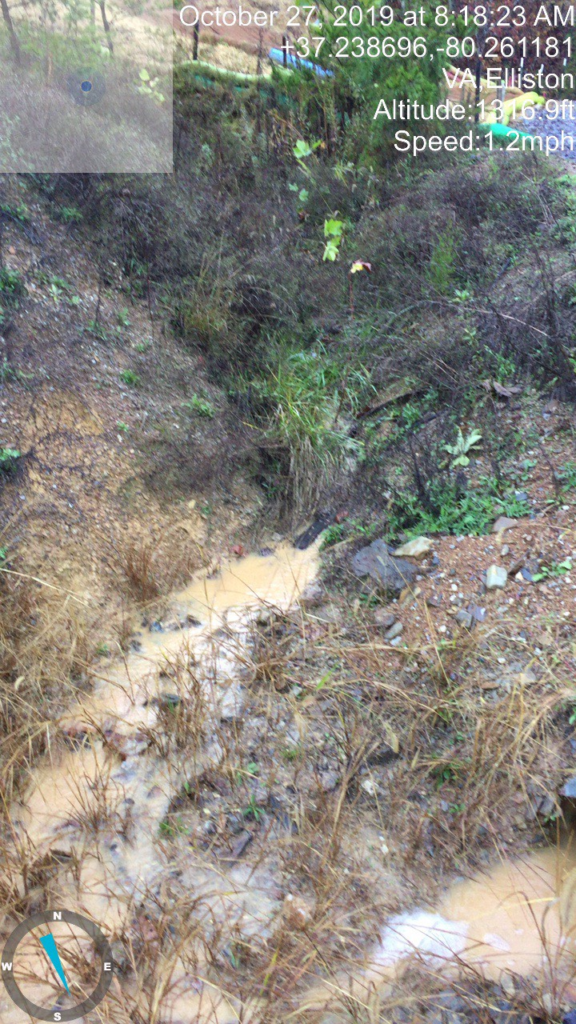
Ground photos taken near Elliston, VA show erosion gullies forming on unstabilized cut slopes disturbed by MVP construction.
Little Creek and Blackwater River in Franklin County
On October 20, 2019, volunteer drone pilots captured images of heavy sediment in Little Creek downstream of the MVP ROW converging with the clearer Blackwater River. Little Creek and the Blackwater River are considered “suitable habitat” for the Roanoke Logperch.
DEQ Field Inspection Photo Log
Additional photos from the DEQ inspection log show locations in need of sediment removal and slopes in need of stabilization. Overwhelmed erosion and sediment control devices are a recurrent issue as described by both volunteers and DEQ inspectors. Some examples of issues highlighted by DEQ inspectors is listed in the tables below. First table is an image log, second is text from the PReP database.
Project Name: Mountain Valley Pipeline Date: Wednesday, October 30, 2019
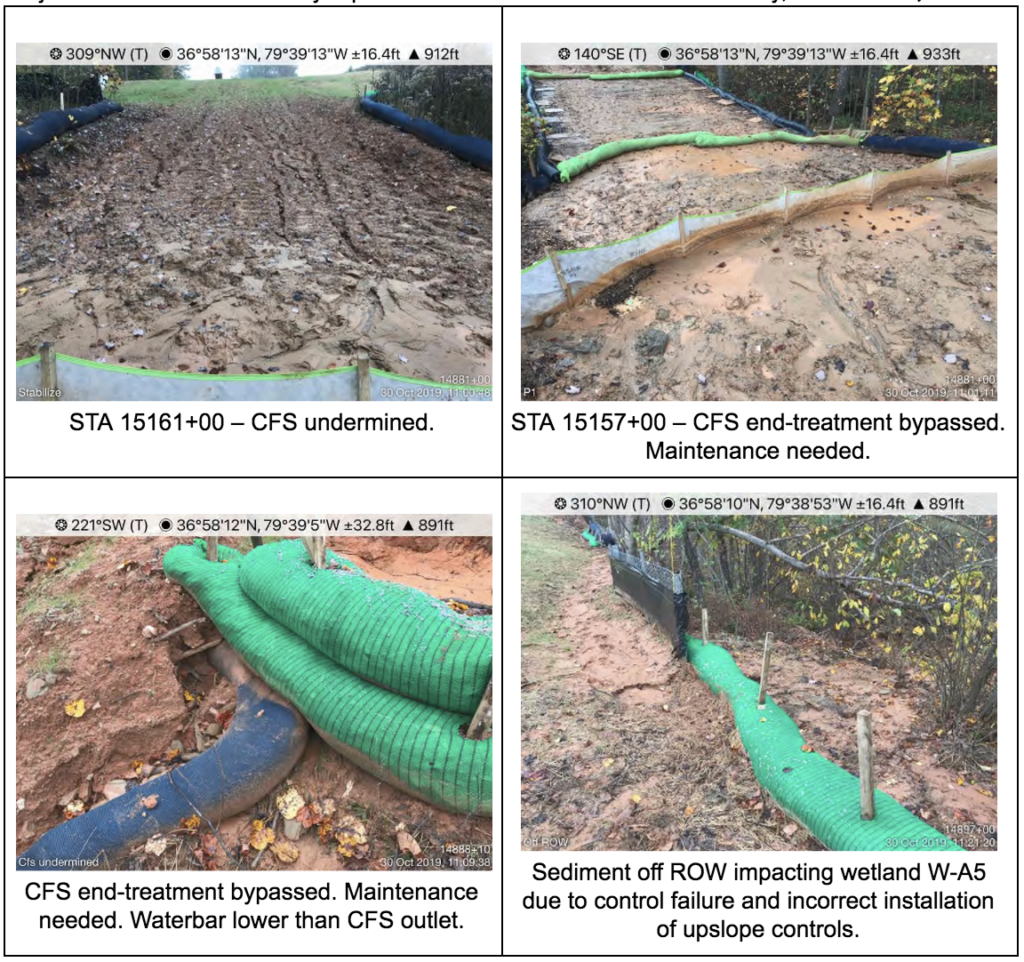
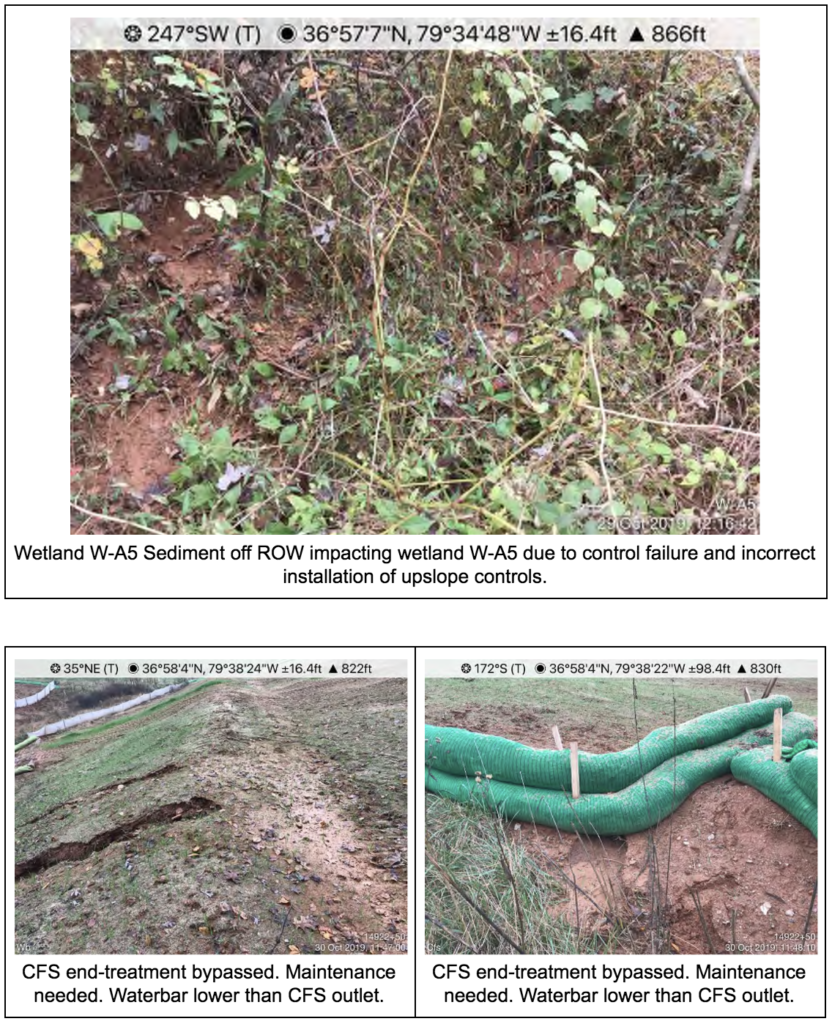
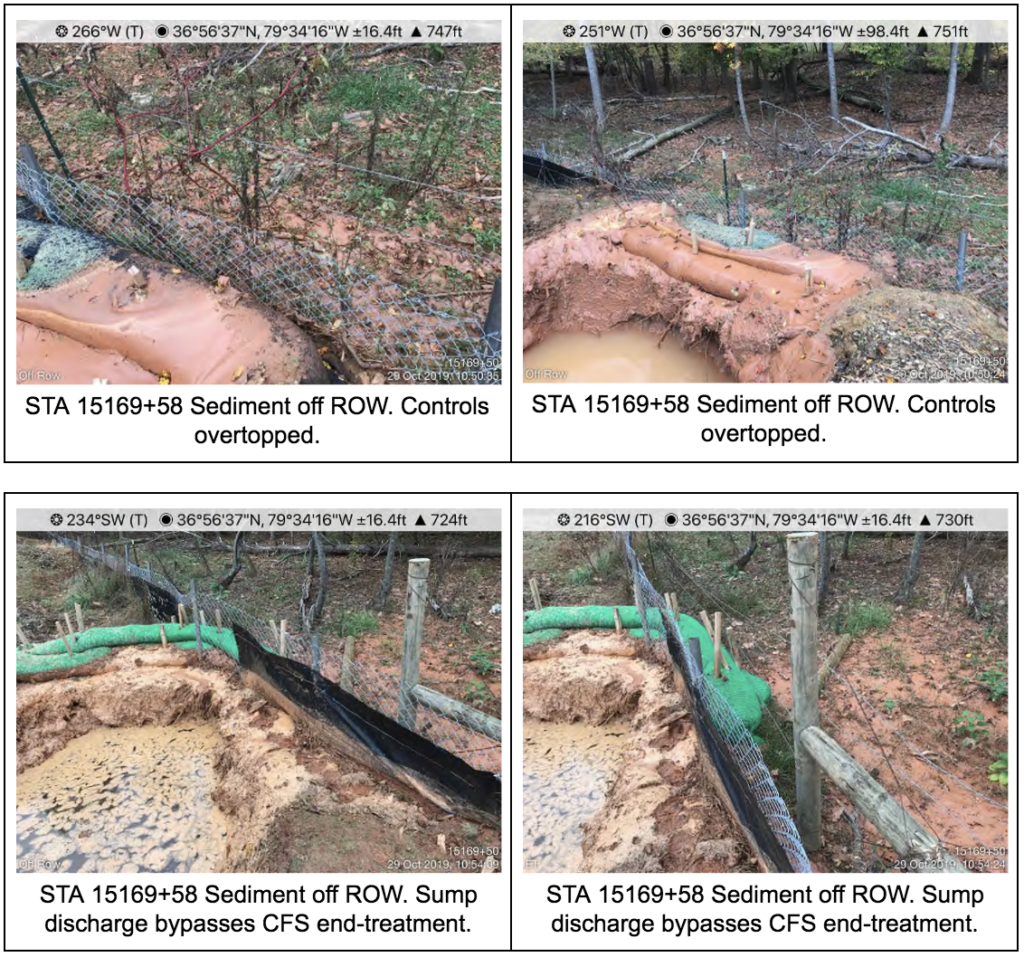
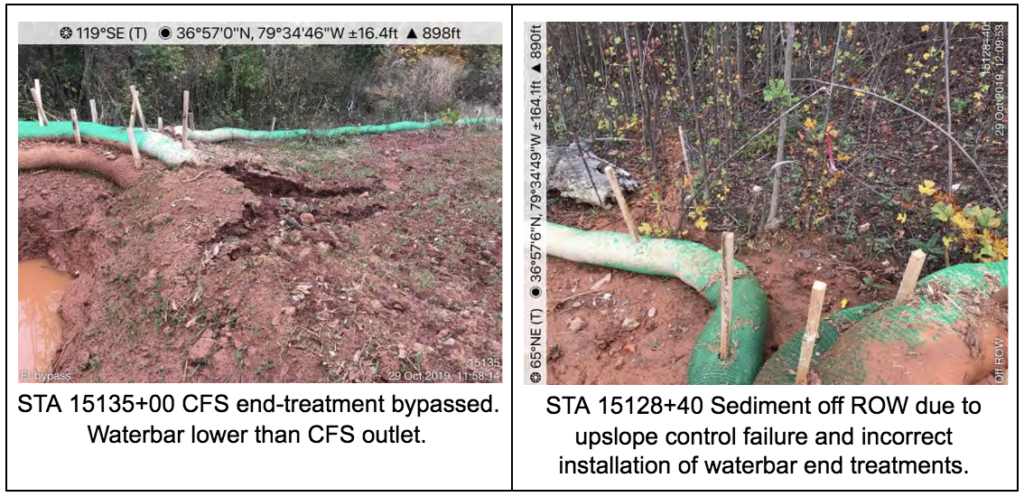
October 31, 2019: Sediment-laden water leaving MVP’s right-of-way at Bradshaw Road.
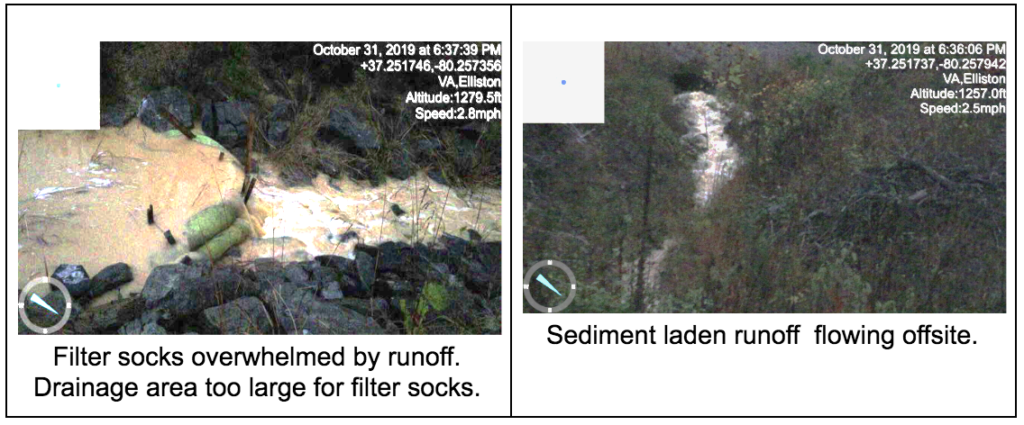
December 1, 2019: The unnamed tributary (background) running adjacent to Yellow Finch Lane (foreground) feeds into the Roanoke River, which is Roanoke logperch habitat. Filter sock overwhelmed by runoff. Sediment flowing offsite.
Regulatory Reported Incidents
Since our last report in September 2019, there have been eight erosion control problem incidents reported to the DEQ PReP database. Several of the recurrent problem areas are listed in the table below:
| Incident Date/Time 10/20/2019 11:45:00AM | Large sediment plume coming from Little Creek into the North Fork of the Blackwater River. There is a significant amount of sediment in the Little Creek stream bed. This seems like a build-up of sediment that accumulated during work done under invalidated permits from the US Army Corps of Engineers and US Fish and Wildlife Service, accompanied by inadequate steps taken to protect the environment and endangered species. Sediment is migrating downstream with each rain event as a result of Mountain Valley Pipeline discharges upstream of this creek/river intersection. A full report with photos will be sent to John McCutcheon and Jerome Brooks. |
| Incident Date/Time 10/27/2019 8:05:00AM | Sedimentation reported leaving MVP ROW and flowing into Bradshaw Creek and the North Fork Roanoke River. Photos show low turbidity upstream of MVP ROW, sediment-laden water leaving the ROW, and turbidity impacts downstream of MVP ROW. Observer indicates that failure of silt socks on this site has been ongoing. |
| Incident Date/Time 10/20/2019 9:47:00AM Closure Date/Time 11/27/2019 11:16:51AM | Email text: “It appears MVP had some issues containing sediment on the ROW. Bradshaw creek once again was considerably less turbid upstream of the ROW and very turbid downstream. I also documented the confluence of Bradshaw creek and the North Fork of the Roanoke River showing how Bradshaw was very turbid. Given the dry weather and fine silt nature of the soil MVP has disturbed I am not surprised this happened during a relatively gentle and light rainfall. Additionally I monitored the ROW over on Yellow Finch Road and documented some sediment laden water spilling over the sediment socks into an UNT. Above Yellow Finch there was some significant slippage of soils. Fortunately it was contained to the ROW, but I suspect a heavier rain could cause a significant landslide, despite their SE control pellets that have been dispersed here. I’ve lived here for 15 years and have NEVER seen this amount of sediment in Bradshaw Creek. |
Conclusions and Request
During August and September, there was a drought with little rain and no incidents of erosion control problems were reported. In October, all construction was halted due to the court decision to vacate the U.S Fish and Wildlife Certifications for Biological Opinion and Incidental Take Statement. Currently, primary construction activities consist of maintenance of erosion and sediment control measures.
When rain fell during October, repeat occurrences of sediment pollution in Bradshaw Creek and the North Fork Roanoke River were reported to the MVW and DEQ. Three times in less than thirty days, volunteers photographed high sediment content in Bradshaw Creek below the MVP right-of-way. This is a recurring problem area which is not stabilized sufficiently to contain sediment onsite. This area was not under construction a year ago and these problems were not occurring.
Franklin County also reported recurrent erosion control problems. Sediment pollution from MVP construction continues to flow into the Blackwater River as shown in photographs and reported to DEQ. The Blackwater River is habitat for the Roanoke Logperch, an endangered species. This is a serious violation of the Endangered Species Act. Inadequate stabilization of the right-of-way and increased runoff from graded areas continues to flow from disturbed areas into adjacent streams and rivers. Downstream channel scour due to increased stormwater runoff compounds and exacerbates erosion problems in upland streams which then flows into larger streams.
On page 7, the DEQ inspector photograph shows sediment flowing off ROW impacting wetland W-A5 due to erosion control device failures and incorrect installation of upslope controls. The MVP impacts numerous acres of wetlands along its route. The inaccessibility of the site makes it difficult for inspectors and volunteers to document and report upland wetland impacts. With the numerous wetlands crossed, and the reported wetland W-A5 shown in this report, it is difficult to determine the total impacts to wetlands along the route. How many other wetlands have been impacted by sediment flowing off the Right-of-way?
As reflected in these reports, the erosion and sediment control plans are deficient in many respects. The Mountain Valley Pipeline is constructing a large diameter pipeline across terrain that is not suitable by nature for a pipeline of this size. The company has graded and modified steep slopes to conform to its interests in building a pipeline through rugged terrain to obtain the most direct and less costly path. Due to inhospitable terrain, contractor errors and inadequate oversight by DEQ, adequate water quality protection cannot be provided and sediment continues to to flowing into adjacent water bodies.
Despite efforts to revegetate steep, mountainous slopes after construction, slopes between 30% and 50% have a poor chance of revegetating, and slopes over 50% have an improbable chance of revegetating. Extreme erosion causes grave problems such as water pollution, increased flood hazard, loss of fish populations, degradation of habitat, and the general impairment of stream ecosystems. Eroded material accumulates in streams where it buries spawning areas, makes water unsuitable for human use, and reduces channel capacity.
Recurrent problem areas shown in this report demonstrate the inability of the erosion control measures to contain sediment onsite and within the right-of-way. With the recent ruling by the Fourth Circuit Court concerning the Endangered Species Act, recurring problem areas due to inadequate erosion control measures may be a violation of the ESA because of the impacts to the Roanoke Logperch. The Court decision calls into question the validity of the Section 401 Certificate approved by the Board. Under the circumstances, it would be appropriate to rescind the Certificate.
Improvement of Communications and Increased Transparency between Mountain Valley Watch and the Board
In previous SWCB meetings, it was brought to the Board’s attention that DEQ’s reporting and follow-up process of communication is one-sided. The extent of communication from DEQ staff regarding sedimentation and erosion incidents reported to the PReP database is an automated email. Even when full PDF reports are sent directly to DEQ staff, there is no attempt to follow-up or indicate what action may have been taken by staff until PReP database reports are filed.
DEQ staff have routinely mischaracterized their interactions with landowners and advocates along the Mountain Valley pipeline route. Per correspondence from the POWHR Coalition on September 11, 2019, several landowners unable to attend the September 2019 Board meeting reflected that Staff had either inaccurately reported their concerns or had failed to report problems that would reasonably seen within and near the ROW. Also noted was Staff’s failure to communicate reasonably and effectively with landowners in preparation for site visits.
We would be open to discussing with the Board and DEQ Staff of these ongoing communication and transparency issues. As stated in our Introduction, Mountain Valley Watch volunteers have submitted the majority of the incidents reported to the DEQ PReP database and supplemented the reporting of DEQ inspection staff—as such, this material should be regularly and thoroughly reviewed and considered by the Board. To this end, we have repeatedly suggested including an allotment of time for citizen reports similar to that given to Staff at each meeting, which would include an agenda item allocating time for citizen reports and pipelines.
